The information provided in this document is copyright protected and shall not be shared without expressed written permission of Insight Training LLC. The grading matrix that is provided is based on the criteria set forth in NFPA 1801-Standard on Thermal Imagers for the Fire Service. The total grade is a subjective measurement provided by the firefighters who are participating in this process. Their overall grading of the TI can be influenced by their level of education and understanding of these concepts. Therefore, it is highly recommended that this process is not done without professional guidance from the members of Insight Training LLC. The final decision that host organization makes shall be made without no liability or damages claimed against Insight Training LLC; as this organization provides the material but the final authority rests within the host organization who shall make the purchasing decision.
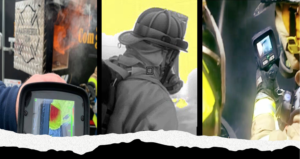
TIC Evaluation Criteria
- Field of View: Each student will see the difference in changing their F.O.V. and how this can benefit their tactics (standard grip versus horizontal, vs. too close/too far).
- Temperature Mode Sensitivity/Avoiding Mode Confusion: Each Student will perform a scan with their respective Thermal Imaging Camera and notice the difference from High Sensitivity to Low Sensitivity. A target of over 300 degrees will be needed.
- Resolution: The students will be scanning the fire environment at three preset distances and note the difference in the resolution in their respective TIC’s and how this can affect their decision-making process.
- Emissivity Demonstration: A shiny metal object will be placed in close proximity of the fire room/heat source and the students will be shown how to interpret the image and differentiate from a reflection and a true heat source. (glass door, stainless fridge, shiny floors etc.).
- MRTD: Minimum Resolvable Temperature Difference: As the students exit the fire room, they will be grouped together to see the difference in the MRTD of their TIC and learn the danger of uniform temperature environments. This demonstration will show how a firefighter can easily blend in with their environment.
- Gray Scale/Colorization Parameters: The students will sit below the thermal layer in the corner with a wide field of view. One of the instructors will open the door and allow the convection currents to move from the fire towards the entry point. They will compare the differences in the TIC’s in the following areas: Convection Current Identification, Speed of switching from High to Low Sensitivity, Thermal Layer Identification, Colorization and Contrast.
- Non-Live Fire Criteria Grading Component: Evaluators will grade the individual models assessed based on ergonomics and who will provide the organization with the best service.
Testing Instructions:
- Write the brand/model of TIC in the upper right hand corner of each page and in the lower left corner of each evaluation form.
- Each evaluator will complete all tests with each TIC they wish to evaluate. They will complete a full evaluation of each model before testing the next brand/model.
- Additional feedback/notes can be written on the back of each evaluation form if more comments are needed.
- The results will be placed in a sealed envelope for the committee to review upon completion of the testing.
Category 1: Field of View
Field of View:__________________________________________________________________________________
OVERVIEW
- Each student will see the difference in changing their F.O.V. and how this can benefit their tactics (standard grip versus horizontal, too close/too far). Students will observe the difference in a wider field of view. They will be shown how to properly scan a room and use each TIC comparatively to make a fair assessment. They will grade these tests in values from 1-5 with 1 being the lowest/poor and 5 being the highest.
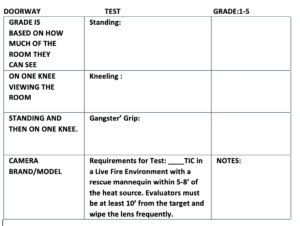
Category 2: Temperature Modes or Gain Evaluation
CRITERIA EVALUATION NAME GRADE DATE
Temperature Mode(s) ___________________________________________
TEST OVERVIEW:
- Each Student will perform a scan with their respective Thermal Imaging Camera and notice the difference from High Sensitivity to Low Sensitivity. A target of over 300 degrees will be needed for this scenario. Students will observe the difference in detail that High Sensitivity makes in discernible details such as identifying victims, downed firefighters, and egress points. Each TIC will be viewed and compared to see which produces a better and more discernible image in high sensitivity and low sensitivity. Evaluators will grade these tests in values from 1-5 with 1 being the lowest/poor and 5 being the highest.
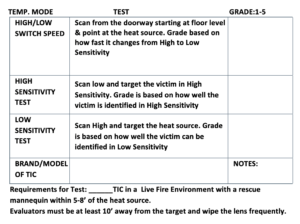
Category 3: Resolution Test Evaluation
OVERVIEW : The students will be scanning the fire environment at three preset distances and note the difference in the resolution in their respective TIC’s and how this can affect their decision-making process. A victim or downed firefighter will be placed within their field of view. The ability to see the victim at preset distances will show the effective range of the TIC and the value of high resolution versus low resolution.
This can also be viewed during the Tactical 360 when firefighters can stand at varying distances from the target and compare the heat signatures that are seen and NOT see by certain TIC’s. Evaluators will grade these tests in values from 1-5 with 1 being the lowest/poor and 5 being the highest. Evaluators should compare high and low sensitivity and average their grade.
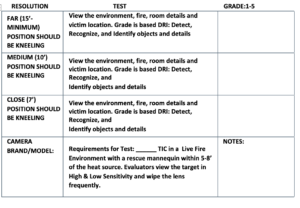
Category 4: Emissivity Evaluation
___________________________________________________________________
OVERVIEW
- Emissivity Demonstration: A shiny metal object will be placed in close proximity of the fire room and the students will be shown how to interpret the image and differentiate from a reflection and a true heat source. (glass door, stainless fridge, shiny floors etc.).

Category 5: MRTD: Minimum Resolvable Temperature Difference(s)
____________________________________________
OVERVIEW:
As the students exit the fire room, they will be grouped together to see the difference in the MRTD of their TIC and learn the danger of uniform temperature environments. This demonstration will show how a firefighter can easily blend in with their environment. They will watch an instructor stand back in the corner and see how they blend in. They will watch the difference in super-heated gear versus the contrast in the SCBA cylinder, the air hose, and the regulator line.
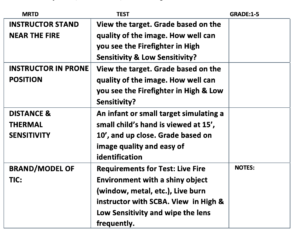
Category 6: Gray Scale/Colorization Parameters
OVERVIEW: The students will sit below the thermal layer in the corner with a wide field of view. One of the instructors will open the door and allow the convection currents to move from the fire towards the entry point. They will compare the differences in the TIC’s in the following areas: Convection Current Identification, Speed of switching from High to Low Sensitivity, Thermal Layer Identification, Colorization and Contrast.

Upon completion of the testing, members should complete the following form, then meet to discuss the following final criteria:
* Ergonomics: Weight, Comfort, Ease of Use.
* Service: Will the vendor chosen provide loaner cameras within 48 hours when a TIC needs service, repair, or replacement?
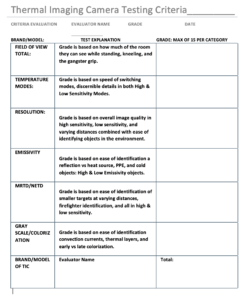
In conclusion, this decision matrix lesson plan is designed to test decision making thermal imaging cameras and NOT situational awareness models. If you or your organization have questions or need further clarification on this process, we gladly offer this program as a course conducted for your organization through Insight Training LLC.
Contact us through the contact link on our website for more information.
Thanks for your support!
Instructor Andy Starnes
Insight Training LLC
Level II Thermography Certified
